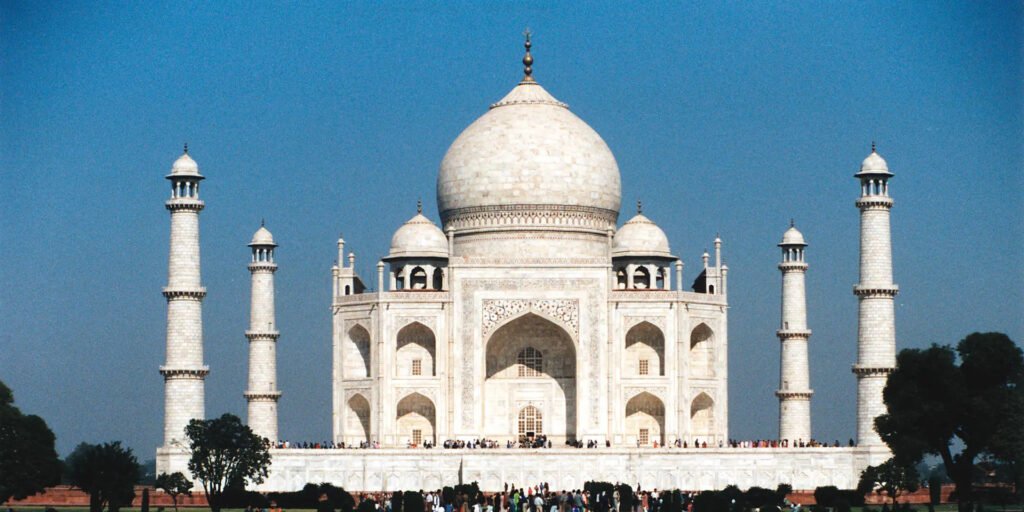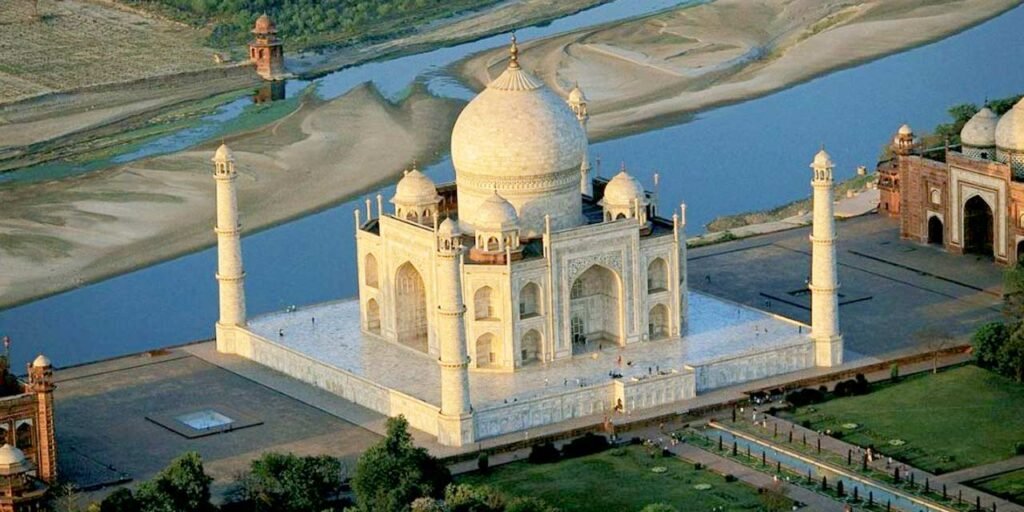Top 30 Unknown and Interesting Facts about The Taj Mahal
Known as the “Crown of the Palace,” the Taj Mahal is a famous mausoleum made of ivory-white marble that is situated in Agra, Uttar Pradesh, India, on the right bank of the Yamuna River.
Shah Jahan, the fifth Mughal emperor, commissioned this UNESCO World Heritage Site in 1631 as a tribute to his wife, Mumtaz Mahal. With more than five million visitors a year, the Taj Mahal is now not only a popular tourist destination in India but also a representation of love.

After Mumtaz Mahal’s death in 1631, work on the Taj Mahal started. This ambitious project was finished in 1653 at an astounding cost of ₹5 million, which is equivalent to over ₹35 billion (about $77.8 million USD) today. While the tomb itself was completed in 1648, the next five years saw the completion of the complex as a whole.
In February 1643, Shah Jahan hosted a ceremony at the mausoleum to mark the 12th anniversary of Mumtaz Mahal’s death, demonstrating his commitment to this architectural wonder.
An excellent example of the Indo-Islamic and Mughal architectural styles is the Taj Mahal. The complex, which is well-known for its symmetrical design, is embellished with features like arches, minarets, and a lot of red sandstone and white marble. The main mausoleum’s elaborate inlay work, which features semi-precious stones, demonstrates the period’s exceptional craftsmanship.
In addition to the mausoleum, the expansive 17-hectare (42-acre) complex features a guesthouse, a large mosque, and formal gardens surrounded by a three-sided crenellated wall. Under the leadership of Ustad Ahmad Lahori, Shah Jahan’s court architect, more than 20,000 craftsmen and workers worked to realize the Taj Mahal’s vision.
The Taj Mahal was acknowledged as a “jewel of Islamic art in India” and for its exceptional cultural significance when it was proclaimed a UNESCO World Heritage Site in 1983. It received additional recognition as one of the New 7 Wonders of the World in 2007. With its artistic and historical significance, the Taj Mahal is still regarded as one of the most renowned examples of Mughal architecture.
1. The Mystery of the Black Taj Mahal
According to legend, Shah Jahan intended to build a second Taj Mahal in black marble on the opposite bank of the Yamuna River, mirroring the white Taj Mahal. This was meant to be his own final resting place, connected by a bridge. Although no concrete evidence exists, remnants of black marble were found across the river, fueling the mystery.
2. It Took Over Two Decades to Complete
The construction of the Taj Mahal began in 1632 and was completed in 1653, taking 22 years to finish. Around 20,000 artisans and craftsmen from across Asia, including Persia and Turkey, worked tirelessly to bring Shah Jahan’s vision to life.
3. A Symbol of Eternal Love
Shah Jahan built the Taj Mahal as a tribute to his beloved wife Mumtaz Mahal, who passed away during childbirth. This monument stands as a testament to their love and has been romanticized as one of the most enduring symbols of devotion in history.
4. The Myth of Amputated Hands
A widespread myth claims that Shah Jahan ordered the hands of the workers to be amputated to ensure they could never recreate such beauty. However, there is no historical evidence to support this, and it is likely a legend that emerged later.
5. A Blend of Architectural Styles
The Taj Mahal combines elements of Islamic, Persian, Ottoman Turkish, and Indian architectural styles. This unique blend gives it a universal appeal and contributes to its recognition as a masterpiece of world heritage.
6. Intricate Calligraphy on Its Walls
The walls of the Taj Mahal are adorned with intricate Arabic calligraphy from the Quran. These verses, crafted by calligrapher Amanat Khan Shirazi, add a divine beauty to the already breathtaking structure.
7. Perfectly Symmetrical Design
One of the most striking aspects of the Taj Mahal is its near-perfect symmetry. The four minarets, the main dome, and the layout of the gardens all follow precise symmetry, adding to the architectural wonder of the structure.
8. Minarets Tilt Outward Slightly
The four minarets surrounding the Taj Mahal are slightly tilted outward. This design was intentional to protect the main mausoleum from damage in case of an earthquake, as the minarets would collapse outward rather than onto the structure.
9. Changing Colors Throughout the Day
The Taj Mahal appears to change color at different times of the day, transitioning from a pinkish hue in the morning, a dazzling white in the afternoon, and a golden shade under the moonlight. This phenomenon is due to the marble’s reflective nature and the effects of light.
10. The Marble Came from Makrana
The stunning white marble used in the Taj Mahal was sourced from Makrana in Rajasthan. It is known for its high quality and has been used in many other famous structures around the world.
11. Precious Stones from Around the World
The Taj Mahal is adorned with inlay work of semi-precious stones from across Asia. Lapis lazuli from Afghanistan, jade and crystal from China, turquoise from Tibet, and many more stones were used to create the intricate designs that decorate the monument.
12. An Optical Illusion
As you approach the main entrance of the Taj Mahal, the monument appears to grow smaller. This is an optical illusion created by the architects, adding to the mystique of the structure.
13. The Tombs of Shah Jahan and Mumtaz Mahal
Contrary to popular belief, the tombs of Shah Jahan and Mumtaz Mahal are not inside the main mausoleum. The actual graves lie in a lower chamber, while the upper chamber houses replicas for visitors.
14. An Unusual Burial Tradition
The Taj Mahal is the only Mughal monument where the emperor and his wife were buried side by side. Mughal traditions typically favored individual mausoleums, but Shah Jahan broke this custom to rest alongside his beloved.
15. No Electrical Lights
The Taj Mahal was designed with natural lighting in mind. It relies entirely on sunlight and moonlight to illuminate its white marble surfaces, adding to its natural beauty.

16. A UNESCO World Heritage Site
In 1983, the Taj Mahal was designated a UNESCO World Heritage Site for its outstanding universal value. It is recognized for both its cultural and architectural significance, symbolizing India’s rich history.
17. Inspiration from Humayun’s Tomb
The design of the Taj Mahal was partially inspired by Humayun’s Tomb in Delhi. Shah Jahan’s grandfather, Emperor Humayun, is buried in a mausoleum that shares architectural elements with the Taj Mahal.
18. Its True Colors Are Hidden
The original structure featured rich colors, with vibrant inlay work and intricate paint. Over the centuries, pollution, time, and restoration have led to a whitening effect, concealing some of its original vibrancy.
19. Subject to Environmental Threats
The Taj Mahal has faced numerous threats from environmental pollution. Acid rain and pollution from nearby industries have caused the white marble to yellow over time, prompting the government to take action to preserve its appearance.
20. Protected by a Buffer Zone
In the 1990s, the Indian government established the Taj Trapezium Zone (TTZ), a 10,400 square kilometer area surrounding the Taj Mahal. This zone limits industrial pollution to protect the monument’s beauty.
21. The Dome’s Double Layer
The main dome of the Taj Mahal is unique in its construction, featuring a double layer. This dual-layered structure creates a grand illusion of height and enhances the acoustic effects within the mausoleum.
22. Architect Ustad Ahmad Lahauri
While multiple artisans contributed to its design, Ustad Ahmad Lahauri, a renowned Persian architect, is widely credited as the chief architect of the Taj Mahal. His expertise helped bring Shah Jahan’s vision to life.
23. Invisible Foundations
The foundations of the Taj Mahal are built on a wooden base, which remains intact thanks to the water from the Yamuna River. The river’s proximity maintains the humidity needed to preserve the wood, preventing it from decaying.
24. It Escaped Destruction During British Rule
During British colonial rule, Lord William Bentinck, Governor-General of India, proposed dismantling the Taj Mahal to sell the marble. Fortunately, the plan was never carried out, and the Taj Mahal was preserved.
25. The Gardens Represent Paradise
The layout of the gardens at the Taj Mahal is inspired by Persian paradise gardens, symbolizing heaven. Divided by four water channels, the garden represents the four rivers of paradise in Islamic tradition.
26. Echo Effect Inside the Dome
Inside the main chamber of the Taj Mahal, any sound echoes multiple times, adding a sense of reverence and enhancing the spiritual atmosphere of the mausoleum.
27. Moonlight Viewing
The Taj Mahal allows night viewing during full moon nights, when the marble reflects the moonlight, creating a serene and magical experience. This special arrangement offers a unique way to appreciate its beauty.
28. Inspired by Islamic Architecture
The Taj Mahal’s design incorporates features of Islamic architecture, such as the dome, minarets, and calligraphy. This Islamic influence reflects the Mughal dynasty’s connection with Persian and Central Asian culture.
29. The Cost of Construction
The construction of the Taj Mahal reportedly cost around 32 million rupees at the time, which would amount to billions today. The immense cost reflects Shah Jahan’s dedication to creating an unparalleled masterpiece.
30. Shah Jahan’s View from Agra Fort
After being deposed by his son Aurangzeb, Shah Jahan spent his final years imprisoned in Agra Fort. From his cell, he could see the Taj Mahal, the eternal resting place of his beloved Mumtaz, until his last days.


